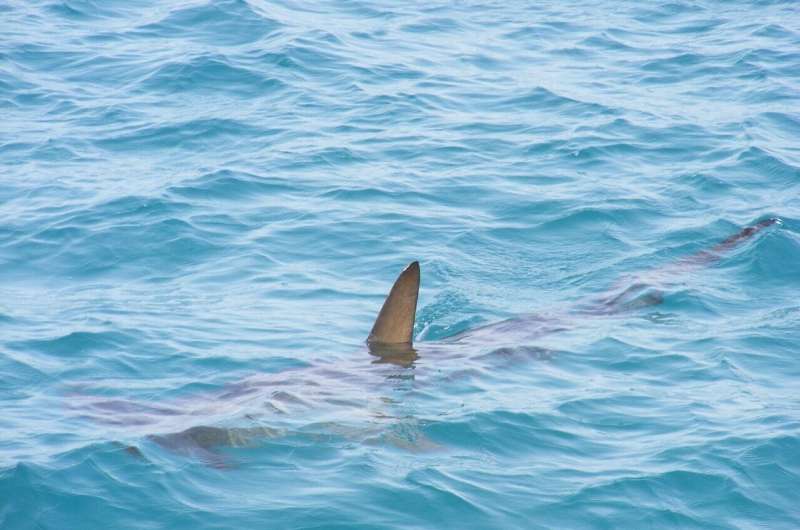
Credit: Pixabay/CC0 Public Domain
The shark that bit a swimmer in Del Mar last month and was hospitalized with serious injuries was a great white shark, about 9 feet and between 6 and 8 years old.
The decision came as a result of analysis of DNA left on the swimsuit the swimmer wore on June 2 and bite marks on the fabric, said Chris Lowe, director of the Shark Lab at Cal State Long Beach.
It’s unclear why the shark bit Caleb Adams, 46, as he swam with the ball about 100 yards near Del Mar’s main lifeguard tower. Adams suffered injuries to his torso, left arm and hand while swimming Sunday morning on an overcast day with muddy water.
Swimmers heard Adams’ screams and used the surf to get him to the beach, where lifeguards and others administered first aid and used a tourniquet to stop his bleeding before loading him into an ambulance.
Adams told CBS 8 he was surprised by how big the shark was and felt lucky to have survived. At one point, he punched a shark while it was biting him and injured his hand.
“I think my injuries show that this is part of what a shark can do, so I can count myself lucky,” Adams told the station.
Adams has resumed swimming, but this time only in a pool, she told CBS 8.
Lowe said it was not possible to determine whether the shark in the Del Mar incident was male or female. Fully grown white sharks can reach lengths of up to 23 feet and live 45 to 70 years.
It is not clear why sharks sometimes bite swimmers. Lowe said they may be in feeding mode and may mistake a human for food or bite as a defensive measure.
The water between Del Mar/Solana Beach and Torrey Pines is a white shark nursery where many juveniles congregate. Researchers have identified about 40 sharks in the area, some of which stay for weeks or months. Lowe said his group is trying to figure out why the sharks hang around certain beaches, but they may prefer the water temperature, find plenty of stingrays and fish to eat, and avoid predators by staying in shallow water.
Drones flying over such areas show that sharks are often very close to swimmers, surfers and others.
“Basically the advice is no different from next day (June 2),” Lowe said. “People need to be aware that this is an aggregation site and that there are sharks out there.”
Water samples taken after the June 2 incident may be tested for DNA in an attempt to identify more of the sharks in the area.
“We have to sequence all the DNA and then try to put it back together to see if we can identify (the shark) as an individual,” Lowe said. “It’s a new technique, it’s never been done before, and I don’t have the money to do it. So I’m going to try to find the money to do the part.”
Scientists can use DNA data to try to build shark family trees. “We can build these libraries and ask who is related to whom,” he said. Such information can help scientists determine how many sharks are present in the area and how they are related.
Before that can be done, Lowe said funding is needed to develop the California Shark Beach Safety Program.
State lawmakers appropriated $3.75 million for the program in 2018. It was supposed to last five years, but Lowe extended it to six. However, that money will expire on September 1, and new state funds have not been allocated.
The program covers 600 miles of coastline from Morro Bay to San Diego – using trackers, sharks, drones and acoustic equipment to monitor shark movements and behavior. A team of 15 people, including students, works on the project.
The program is designed to improve public understanding of sharks and reduce safety risks. Part of the effort is educating lifeguards about sharks and keeping them informed about shark activity on their beaches.
“The technology is expensive, but it gives us data we can’t get any other way,” said Lowe, who has taught marine biology at Cal State Long Beach for 25 years.
Lowe said he hopes to secure funding from private donors, or possibly city and county governments, to keep the program afloat. “We’re getting a little desperate,” he said.
2024 San Diego Union-Tribune. Distributed by Tribune Content Agency, LLC.
Quote: DNA tests confirm shark bit California swimmer was white shark (2024, July 15) Accessed July 16, 2024 at https://phys.org/news/2024-07-dna-shark-bit-california-swimmer. Retrieved from html.
This document is entitled. No part may be reproduced without written permission except for any fair dealing for personal study or research purposes. Content is provided for informational purposes only.
#DNA #tests #confirmed #shark #juvenile #great #white #shark #swimming #California #waters